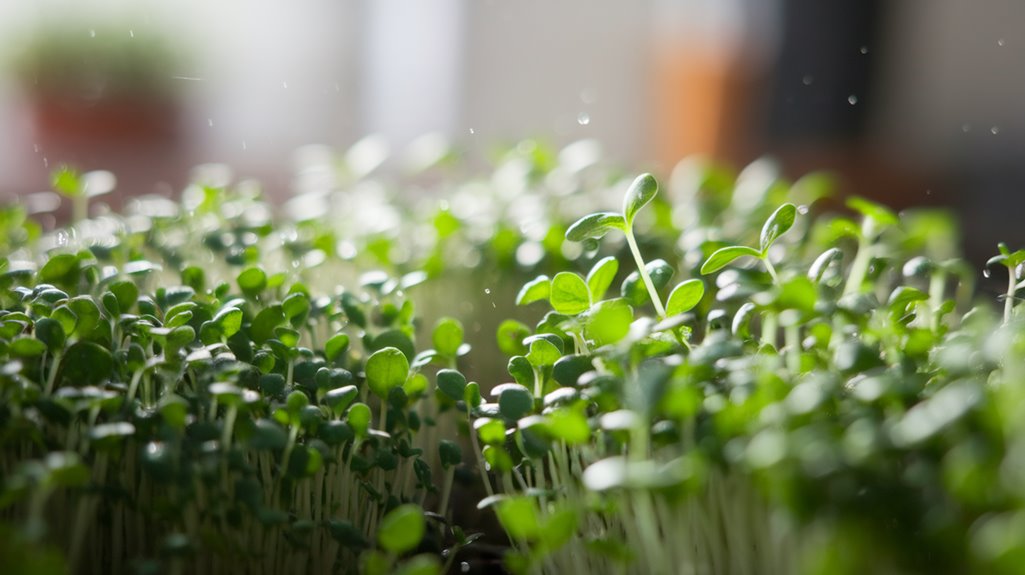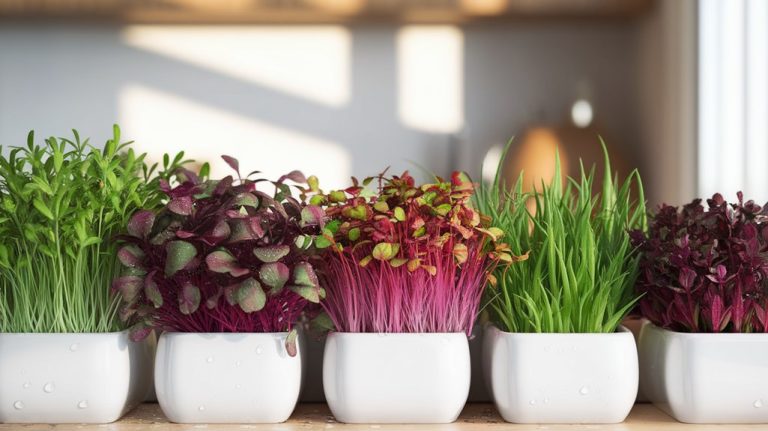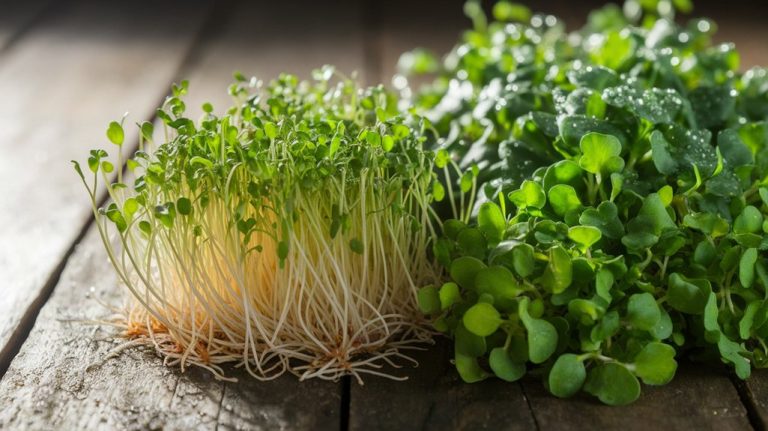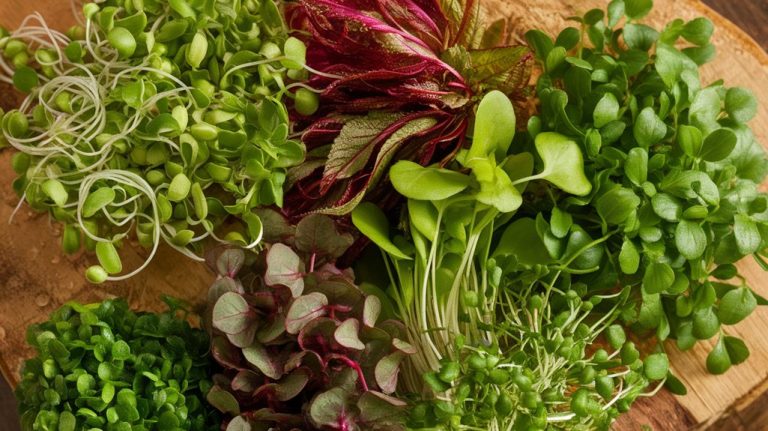Microgreens for Weight Loss: Fact or Fiction?
Microgreens are a fantastic food for weight loss! They’re packed with nutrients, offering up to 40 times the vitamins and minerals of mature greens, while being low in calories. Their high fiber content helps control hunger and adds volume to meals without the extra calories. Including these vibrant greens in your diet can enhance flavor and nutrition, making weight management easier. If you’re curious about how to incorporate them into your meals and their other benefits, there’s more to discover!
Key Takeaways
- Microgreens are low in calories, making them an excellent addition to weight-loss diets without compromising nutrition.
- Their high nutrient density provides essential vitamins and minerals while keeping caloric intake low.
- Rich in dietary fiber, microgreens promote satiety and help control hunger, aiding weight management.
- Incorporating microgreens into meals enhances flavor and nutrition, supporting a balanced diet conducive to weight loss.
- Scientific research suggests microgreens can assist in weight management by providing lower-calorie meal options without sacrificing nutrients.
What Are Microgreens?
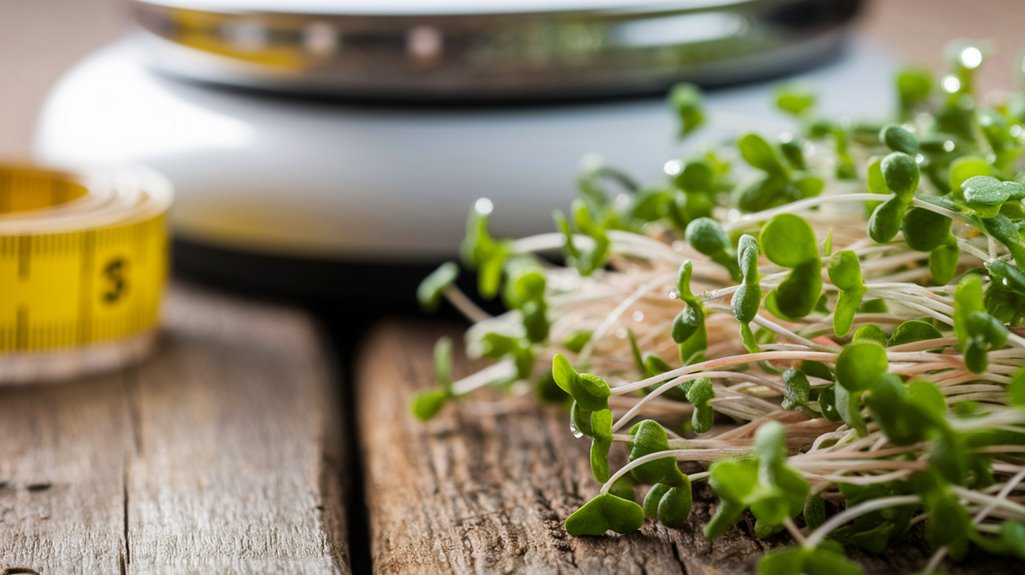
Microgreens are young, edible plants that pack a powerful nutritional punch. They’re typically harvested just after the first true leaves appear, making them small yet incredibly vibrant.
You’ll find a variety of microgreens, including radish, kale, and basil, each offering distinct flavors and textures. What fascinates me is their growing popularity in culinary dishes, not just for taste but also for aesthetics.
Unlike mature plants, microgreens contain concentrated levels of vitamins, minerals, and antioxidants in a tiny package. I’ve learned that they’re often grown indoors or in controlled environments, making them accessible year-round.
Whether you’re a gardener or a food enthusiast, incorporating microgreens into your meals can elevate your eating experience while providing a fresh burst of nutrition.
Nutritional Benefits of Microgreens
Incorporating microgreens into your diet can significantly boost your nutritional intake.
These tiny greens are packed with essential nutrients that can support overall health. Here’s what I’ve found about their benefits:
- High in Antioxidants: Microgreens can contain up to 40 times more antioxidants than mature greens, helping combat oxidative stress.
- Rich in Vitamins: They’re a fantastic source of vitamins A, C, and E, which are vital for immune function and skin health.
- Mineral Content: Microgreens provide important minerals like calcium, magnesium, and potassium, supporting bone and heart health.
- Low in Calories: Despite their nutrient density, they’re low in calories, making them a great addition to a weight-loss-friendly diet.
Incorporating these little powerhouses can truly make a difference!
The Role of Microgreens in a Balanced Diet
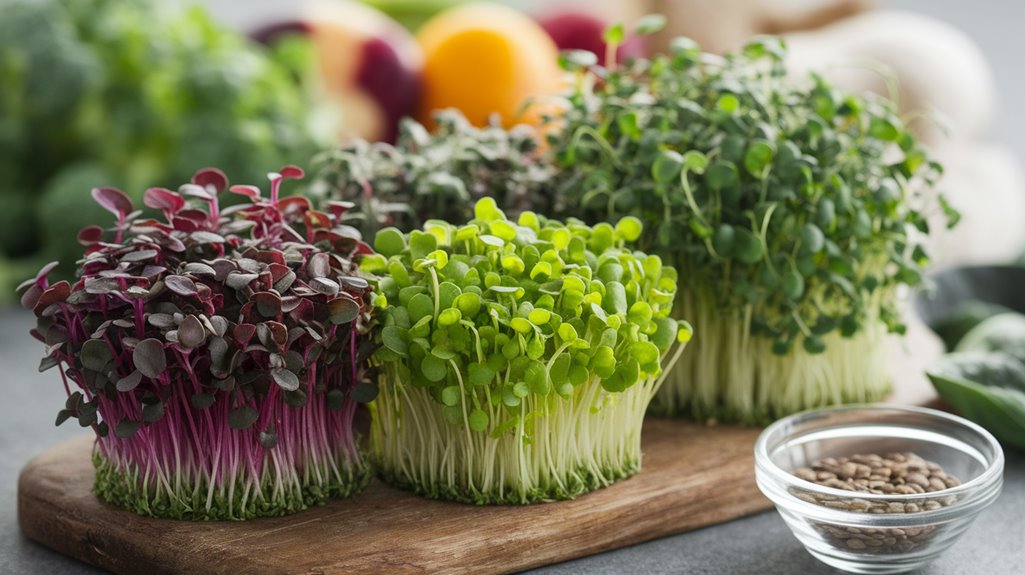
When I think about incorporating microgreens into my meals, I see them as a powerhouse of nutrient density that can enhance my overall diet.
Not only are they a low-calorie snack option, but they also add exciting flavors and variety to my dishes. This combination makes them an excellent choice for anyone looking to maintain a balanced diet while pursuing weight loss.
Nutrient Density Explained
Nutrient density is a crucial concept in understanding what makes certain foods more beneficial for our health. When I think of microgreens, I see them as a powerhouse of nutrients packed into tiny leaves. They offer significant benefits without excessive calories, making them a smart choice for anyone looking to enhance their diet.
Here are four key aspects of nutrient density in microgreens:
- Vitamins: Microgreens are rich in vitamins A, C, and K, essential for immune function and skin health.
- Minerals: They provide vital minerals like calcium and iron, crucial for bone strength and oxygen transport.
- Antioxidants: Many microgreens contain antioxidants that combat oxidative stress and inflammation.
- Fiber: They contribute to digestive health, promoting regularity and satiety.
Incorporating these into my meals has truly made a difference!
Low-Calorie Snack Option
Microgreens serve as an excellent low-calorie snack option, providing a burst of flavor and nutrition without adding excessive calories to my diet.
These tiny greens, like arugula and radish, are packed with vitamins and minerals, making them a smart choice for anyone looking to maintain or lose weight. A typical serving contains around 20-30 calories, which means I can enjoy them guilt-free.
They’re versatile too; I can toss them in salads, blend them into smoothies, or simply munch on them raw. Incorporating microgreens into my snacking routine not only satisfies my hunger but also keeps my nutrient intake high.
Ultimately, they’re a simple way to enhance my diet while staying within my calorie goals.
Adding Flavor and Variety
While I often focus on calorie counting, adding flavor and variety to my meals is just as crucial for maintaining a balanced diet.
Microgreens are a fantastic way to enhance my dishes, offering both taste and nutrition. Here are four ways I incorporate them:
- Salads: I toss a handful of arugula or radish microgreens into my salads for a peppery kick.
- Sandwiches: A layer of basil or cilantro microgreens elevates my sandwiches with fresh, vibrant flavors.
- Smoothies: I blend spinach microgreens for added vitamins without changing the taste.
- Soups: Garnishing soups with pea shoot microgreens adds a delightful crunch and visual appeal.
Do Microgreens Aid in Weight Loss?

As I explore the potential of microgreens for weight loss, I find their nutrient density and low-calorie profile particularly compelling.
These tiny greens pack a punch in vitamins and minerals while adding minimal calories to meals.
This combination could make them a smart addition to a weight-conscious diet.
Nutrient Density Benefits
Nutrient density plays a crucial role in weight loss, and incorporating microgreens into your diet can be a smart strategy.
These tiny plants pack a powerful nutritional punch, making them an excellent addition to meals. Here’s what I’ve found about their benefits:
- Vitamins: Microgreens are rich in vitamins A, C, E, and K, which support overall health.
- Minerals: They provide essential minerals like calcium, magnesium, and potassium, crucial for metabolic processes.
- Antioxidants: Many microgreens contain higher levels of antioxidants than their mature counterparts, helping combat oxidative stress.
- Fiber: Adding these greens can increase your fiber intake, promoting satiety and aiding digestion.
Low-Calorie Addition
If you’re looking for a way to enhance your meals without adding many calories, microgreens are an ideal choice. These tiny greens pack a punch in flavor and nutrients while remaining low in calories.
For instance, a cup of microgreens typically contains just 5 to 10 calories, making them an easy addition to salads, sandwiches, or smoothies. Research shows that incorporating low-calorie, nutrient-dense foods like microgreens can help manage weight by promoting satiety without excess calories.
They’re also rich in vitamins and antioxidants, which support overall health. However, while microgreens can be a helpful tool in your weight loss journey, they shouldn’t replace a balanced diet.
Combining them with a variety of whole foods is key to achieving sustainable results.
Comparing Microgreens to Other Superfoods
While many superfoods boast impressive health benefits, microgreens stand out due to their concentrated nutrient profiles and versatility.
When I compare microgreens to other popular superfoods, I notice several distinct advantages:
- Nutrient Density: Microgreens can contain up to 40 times more nutrients than mature plants, making them a powerhouse for vitamins and minerals.
- Low-Calorie: Like kale or spinach, microgreens are low in calories, which can aid in weight loss efforts.
- Flavor Variety: They offer diverse flavors, from spicy radish to sweet pea shoots, enhancing meals without added calories.
- Easy to Grow: Unlike some superfoods, microgreens can be grown indoors, making them accessible year-round.
How to Incorporate Microgreens Into Your Meals
Incorporating microgreens into my meals is both simple and rewarding, as these tiny greens can elevate the nutritional value of any dish.
I love adding them to salads for an extra crunch and burst of flavor. They also work well as a garnish on soups and stews, enhancing both presentation and taste.
For breakfast, I sprinkle microgreens on omelets or avocado toast, turning a regular meal into something special.
Smoothies are another great option; blending them in adds nutrients without overpowering the flavor.
I’ve even started using them in wraps and sandwiches, making each bite more vibrant.
With their versatility, it’s easy to include microgreens in my daily diet, boosting both nutrition and enjoyment.
Scientific Studies on Microgreens and Weight Management
Microgreens not only enhance the flavor and nutrition of meals, but they also have gained attention in scientific research for their potential role in weight management.
Studies suggest that these tiny greens may aid in weight loss through various mechanisms:
- Nutrient Density: Microgreens are packed with vitamins and minerals, allowing for nutrient-rich meals without excessive calories.
- Fiber Content: They often contain dietary fiber, which promotes satiety and helps control hunger.
- Antioxidant Properties: Many microgreens possess antioxidants that may support metabolic health.
- Low Caloric Load: They can add volume to meals without significantly increasing caloric intake.
While more research is needed, incorporating microgreens into a balanced diet might be a valuable strategy for those looking to manage their weight effectively.
Tips for Growing Your Own Microgreens
Growing your own microgreens can be a rewarding and straightforward endeavor. First, choose your seeds—popular options include kale, radish, and sunflower. I recommend starting with organic seeds to ensure quality and taste.
Next, select a container with drainage holes; seed trays work well. Fill it with a seed-starting mix, then evenly spread the seeds and cover them lightly with soil. Water gently to avoid displacing the seeds.
Place your container in a sunny spot or under grow lights, and keep the soil moist but not soggy. In about 7 to 14 days, you’ll see your microgreens sprouting.
Harvest them using scissors, cutting just above the soil line. Enjoy your fresh, nutrient-rich addition to meals, enhancing both flavor and health!
Frequently Asked Questions
Conclusion
In conclusion, while microgreens are packed with nutrients and can enhance a balanced diet, their direct impact on weight loss isn’t as clear-cut. They’re not a magic solution, but they can complement other healthy habits. By incorporating microgreens into your meals, you can enjoy their flavor and health benefits. Remember, successful weight management ultimately relies on a holistic approach that includes a variety of foods, regular exercise, and mindful eating practices.

